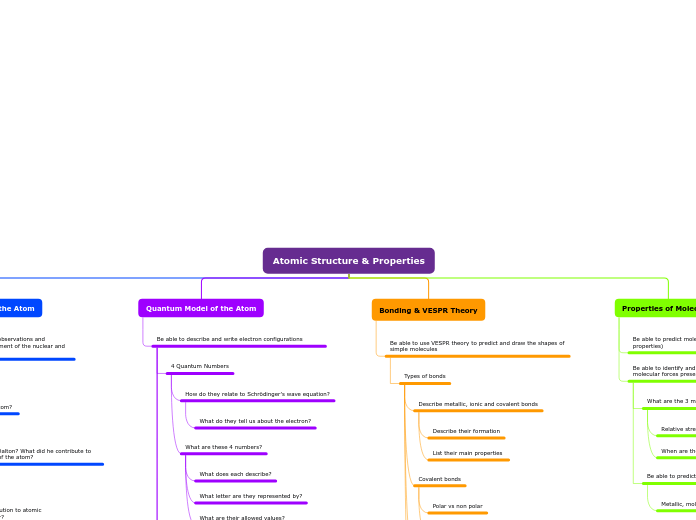Atomic Structure & Properties
Historical Understandings of the Atom
Be able to explain how experimental observations and inferences contributed to the development of the nuclear and planetary models of the atom
Dalton's model of the atom
What is the nature of the atom?
What is he missing?
Why do we still talk about Dalton? What did he contribute to our current understanding of the atom?
Thomson's model of the atom
What was his major contribution to atomic theory/what did he discover?
What did his model of the atom look like?
What is missing from his model?
Why do we still talk about Thomson? What did he contribute to our current understanding of the atom?
Rutherford's model of the atom
Describe Rutherford's gold foil experiment, including what he predicted would happen, and what actually happened
What did the outcome of the gold foil experiment tell Rutherford about the structure of the atom?
What did scientists identify as the 2 major issues associated with Rutherford's model?
Bohr's model of the atom
How did Bohr address/explain the issues associated with Rutherford's model
What are the main postulates of Bohr's atomic theory?
What does it mean that electrons are quantized?
Describe what needs to happen for electrons to move between energy levels
How does light energy play a role?
What is a photon?
What do some photons have more energy than others?
Connect the movement of electrons between energy levels to the formation of a discrete line spectrum
What is a discrete vs. continuous line spectrum?
What does a discrete line spectrum tell us about the nature of the atom?
Apply the relationship between the energy, frequency and wavelength of light to the emission spectrum
Identify the shortcomings of Bohr's theory/model
Schrodinger's model of the atom
Why was a new model needed?
What couldn't Bohr's explain?
What new discovery was made?
Where did Schrödinger & de Broglie come up with the idea that electrons behave as standing waves?
What experiment did they conduct?
What are the key ideas of the new quantum mechanical model? (HINT: there are 2)
What are we still keeping from Bohr's model?
What is the difference between Bohr's 'orbit' & the quantum 'orbital'?
Why can't we know an electrons exact location?
What principle describes this phenomenon?
What does solving Schrödinger's wave equation tell us?
Quantum Model of the Atom
Be able to describe and write electron configurations
4 Quantum Numbers
How do they relate to Schrödinger's wave equation?
What do they tell us about the electron?
What are these 4 numbers?
What does each describe?
What letter are they represented by?
What are their allowed values?
Write an electron configuration for any element on the periodic table
Write the shorthand/noble gas configuration as well
Define and apply the Aufbau principle, Hund's rule & the Pauli exclusion principle
Identify exceptions to the Aufbau principle
Draw box orbital diagrams according to energy level
Again, be able to apply the Aufbau principle, Hund's rule and the Pauli exclusion principle
Be able to state the 4 quantum numbers for a particular electron of a particular element
What are its n, l, ml and ms values?
Can you easily obtain this information off of the periodic table?
Bonding & VESPR Theory
Be able to use VESPR theory to predict and draw the shapes of simple molecules
Types of bonds
Describe metallic, ionic and covalent bonds
Describe their formation
List their main properties
Covalent bonds
Polar vs non polar
Use EN values to predict polarity of bond
Lewis Structures
For ionic and covalent compounds
Covalent: incomplete & expanded octet, polyatomic ions
Use Lewis structures to predict VSEPR shape
Bond angles?
Hybridization?
Properties of Molecules
Be able to predict molecular polarity (and hence physical properties)
Be able to identify and explain the types of inter- and intra-molecular forces present in and between molecules
What are the 3 main types?
Relative strengths?
When are they present?
Be able to predict properties of solids based on bonds & IMFs
Metallic, molecular, ionic, covalent networks
